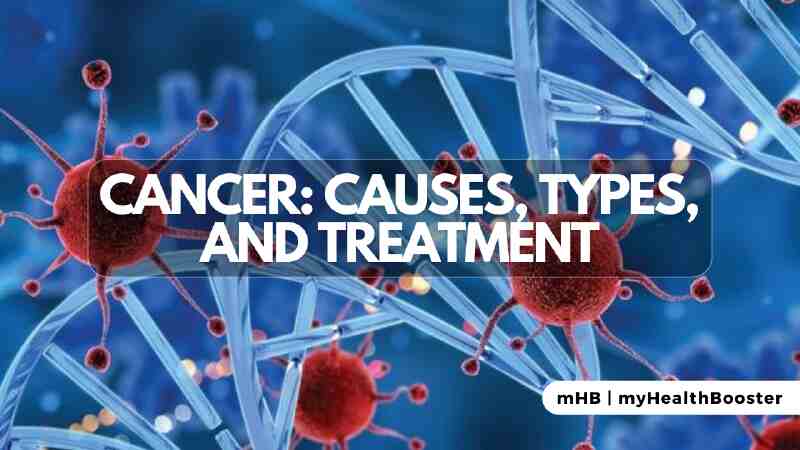Cancer, characterized by uncontrolled cell growth and invasion, results from DNA defects, genetic mutations, infections, and environmental factors. This article provides a thorough exploration of cancer, covering its definition, benign and malignant tumors, metastasis, causes, common types, staging, diagnosis, and treatment options.
Understanding Cancer
- Cellular Aberrations: Cancer originates when cells accumulate DNA defects, losing their ability to self-destruct when severely damaged.
- Risk Factors: Inherited genetic defects, infections, environmental exposures (e.g., air pollution), and poor lifestyle choices (smoking, alcohol use) contribute to cancer risk.
Benign vs. Malignant Tumors
- Benign Tumors: Local growth without invasion, potentially dangerous if pressing against vital organs.
- Malignant Tumors: Capable of invading tissues and spreading (metastasis), a hallmark of cancer.
Metastasis
- Metastasis Process: Cancer cells break free, travel via lymphatic system or bloodstream, and form secondary tumors.
- Naming Metastatic Cancer: Retains the name of the primary cancer, influencing staging and treatment decisions.
Causes of Cancer
- Genetic Mutations: BRCA1 and BRCA2 mutations increase breast and ovarian cancer risks.
- Environmental Factors: Ultraviolet radiation, air pollutants, microbes (e.g., H. pylori, HPV), and lifestyle choices (poor diet, inactivity, tobacco, alcohol) contribute to DNA damage.
Types of Cancer
- Carcinoma: Epithelial tissue cancers, including breast, lung, colon, and skin cancers.
- Sarcoma: Arises in connective tissues like bones and muscles.
- Myeloma: Bone marrow plasma cell cancers.
- Leukemia: Blood cancers originating in the bone marrow.
- Lymphoma: Immune system cell cancers, including Hodgkin and non-Hodgkin lymphomas.
- Mixed Cancer: Arises from multiple tissue types.
Common Cancers
- Breast Cancer: Most common in women, affecting 1 in 8 with a significant mortality rate.
- Lung Cancer: Second-most-common cancer, leading cause of cancer-related deaths.
- Prostate Cancer: Most common cancer in men.
- Colorectal Cancer: Second-leading cause of cancer deaths.
- Liver Cancer: Linked to hepatitis and heavy drinking.
- Ovarian Cancer: Affects 20,000 American women annually.
- Pancreatic Cancer: Highest mortality rate among major cancers.
Stages of Cancer
- TNM Classification: Tumor size, lymph node spread, and distant metastasis determine cancer stages (0 to IV).
Diagnosing Cancer
- Diagnostic Tests: Include mammograms, Pap tests, tumor marker tests, bone scans, MRI, tissue biopsies, and PET-CT scans.
Treatment Options
- Surgery: Removal of tumors; debulking and palliative surgeries for specific cases; reconstructive surgery for restoration.
- Radiation Therapy: External or internal radiation to target cancer cells.
- Chemotherapy: Various medications targeting cancer cells, administered orally, intravenously, or topically.
- Other Therapies: Targeted/biological therapies, hematopoietic stem cell transplants, angiogenesis inhibitors, cryosurgery, and photodynamic therapy.
Ongoing Research
- Advancements: Continuous research aims for less toxic and more effective treatments, with ongoing clinical trials available through the National Cancer Institute.
Conclusion
Cancer, a complex and multifaceted disease, necessitates a comprehensive understanding for effective prevention, diagnosis, and treatment. Ongoing research and advancements in various therapeutic approaches offer hope in the quest for a cure. Emphasizing lifestyle choices and regular screenings remains crucial for cancer prevention.
References
- American Cancer Society: “Lymph Nodes and Cancer”, “Signs and Symptoms of Cancer”, “Treatment Types”, “What Causes Cancer?”, “What Is Cancer?”, “Second Cancers in Adults”
- Cancer.gov: “NCI Dictionary of Cancer Terms”, “Helicobacter pylori and Cancer”, “Cancer-Causing Substances in the Environment”, “BRCA1 and BRCA2: Cancer Risk and Genetic Testing”
- CDC: “Leading Causes of Death“
- National Cancer Institute: “Cancer and the Cell Cycle.”, “Cancer Classification.”, “Cancer Staging.”, “Common Cancer Types.”, “Malignant versus Benign Tumors”, “Metastatic Cancer?”, “Types of Treatment.”, “What Is Cancer?”
- UCSFHealth.org: “Basal Cell and Squamous Cell Carcinoma“
